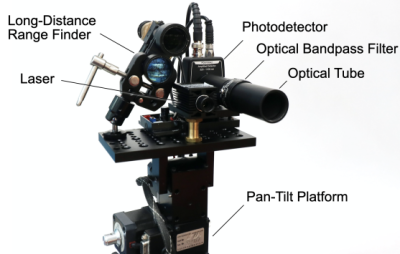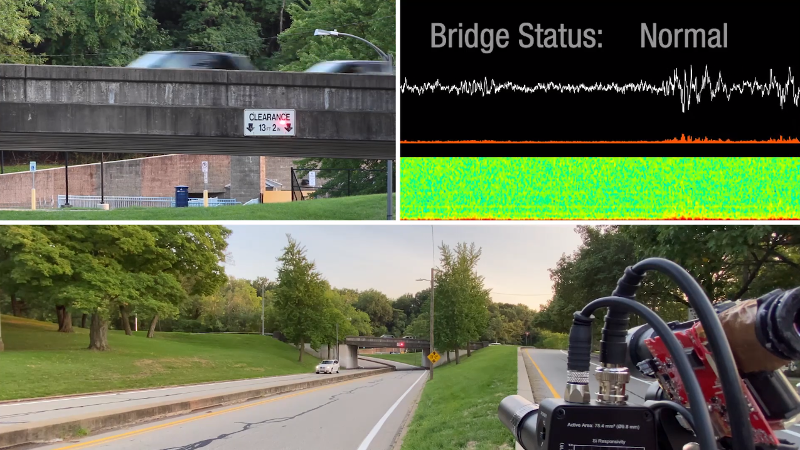It’s difficult to tell with our dull human senses, but everything around us is vibrating. Sure it takes more energy to get big objects like bridges and houses humming compared to a telephone pole or mailbox, but make no mistake, they’ve all got a little buzz going on. With their new automated laser, the team behind VibroSight++ believes they can exploit this fact to make city-scale sensing far cheaper and easier than ever before.
The key to the system is a turret mounted Class 3B infrared laser and photodetector that can systematically scan for and identity reflective surfaces within visual range. Now you might think that such a setup wouldn’t get much of a signal from the urban landscape, but as it so happens, the average city block is packed with retroreflectors. From street signs to road studs and license plates, the team estimates dense urban areas have approximately 7,000 reflectors per square kilometer. On top of those existing data points, additional reflectors could easily be added to particularly interesting devices that city planners might want to monitor.
 Once VibroSight++ has identified its targets, the next step is to bounce the laser off of them and detect the minute perturbations in the returned signal caused by vibrations in the reflector. In the video below you can see how this basic concept could be put to practical use in the field, from counting how many cars pass over a certain stretch of road to seeing how popular a specific mailbox is. There’s a whole world of information out there just waiting to be collected, all without having to install anything more exotic than the occasional piece of reflective tape.
Once VibroSight++ has identified its targets, the next step is to bounce the laser off of them and detect the minute perturbations in the returned signal caused by vibrations in the reflector. In the video below you can see how this basic concept could be put to practical use in the field, from counting how many cars pass over a certain stretch of road to seeing how popular a specific mailbox is. There’s a whole world of information out there just waiting to be collected, all without having to install anything more exotic than the occasional piece of reflective tape.
If this technology seems oddly familiar, it’s probably because we covered the team’s earlier work that focused (no pun intended) on using reflected laser beams for home automation in 2018. Back then they were aiming a much smaller laser at blenders and refrigerators instead of license plates and street signs, but the concept is otherwise the same. While we’ll admit the technology does give off a distinctive Orwellian vibe, it’s hard not to be intrigued by the “Big Data” possibilities afforded by the team’s upgraded hardware and software.















Point it at a window and listen in to anyone. Nice surveillance network.
Every technology can be abused. Can’t you agree this is a very interesting technology and it solves the problem they where set out to solve: Measure the environment, cheaper than other technologies. I think it’s amazing.
If you want to go high-tech, a camera and python is all you need to count cars on a bridge.
What do you do? Point a camera at the python and train a AI to recognise the pain reaction every time a car goes over it?
Oh, wait, I misread that as “a python”.
Mount the laser on the snake’s head…
I want sharks with friggin lasers on their heads…..
Shark-mounted lasers… That degenerated fast! :-D
It can count cars but it can’t return a signal giving early indication of metal fatigue and possible bridge failure.
Why not? Paint a black spot on a white square on regular intervals, and the camera call tell for sure if the distance is changing. With a good HD camera, it can detect small changes.
You don’t need a laser for that.
A camera? This is using a photo-detector which can be sampled at much higher than 30,60 or even 120 fps. The kind of distance offsets that are being measured are much too small to be registered by a camera. But the resonant frequency of the bridge will change with otherwise imperceptible cracks and this will easily be detected with this system.
Pointing with won´t be enough. Unless the window is coated with retroreflectors, you´ll have to follow the reflection of the beam and pout your receptor there. You can defocus the laser to help, but it´s really not “point-anywhere-and-eavesdrop-immediately”
https://en.wikipedia.org/wiki/Laser_microphone
I remember an article in Popular Electronics (or was it Radio Electronics?) magazine back in the late 80s, early 90s that already shows how to do that with a surplus helium laser tube.
I had build such a laser setup from a science fair project I had built in high school, but never got interested in spying on people.
Wonder if a Kinect like setup could achieve something similar but for an entire scene at once!
square cube law strikes again…kinect has barely enough power to sense a few meters ahead with outside lighting. Crank the laser power up and you have an eye hazard…
I guess the concern is you’re spraying the world with the laser? Because actually each beam could be no more powerful than the class 3b used here once diffracted.
Well, IR is nice I guess but it would be better to switch to something visible or something that the eye lens might filter?
Cool piece of technology, but some of the use cases seems like a bit of a stretch. For example, why would you employ a relatively expensive system to monitor parking spaces, when a ordinary camera / webcam with a bit of image processing could achieve the same, and even cover the entire parking lot continuously instead of scanning a single lot at a time?
It’s all fun and games until someone stands or parks a car in front of your retroreflector…
Imagine using a DLP projector instead of a motorized tripod as active element. You could scan every reflective object at once.
how this look in area of human/animals eyes damage ?
what will happen if you point beam to somenones eye or beam will be bounced from some reflective surface ?
not so good if wikipedia is accurate https://en.wikipedia.org/wiki/Laser_safety#Class_3B
Human eyes are quite reflective too, so they might make good targets. Keep your eyes closed if you don’t want them used as laser mics by the government.
This is an academic research article, and as such it is interesting. But you are right — actual deployment of this would violate every laser safety rule in on the books.
They have a paper on the website linked in the article that has a section with more specifics on the safety of the design.
“By defocusing our laser, we can make it eye safe down to around 46cm, where the energy density is under the recommended 2.5mW/cm2 exposure”
“Finally, our system measures the refected light intensity within 50 microseconds of laser power. This is well under the
250-millisecond exposure hazard threshold detailed in [1] if we are
operating under 2.5mW/cm2”
Beam expander and non-point-focus. It’s just easier to start with a laser and expand/defocus than it is to start with a high current LED and collimate/focus, although the LED will work equally well at moderate ranges (few hundred yards).
Yeah I wonder if they considered the eye hazards when they were testing this devise in the above photos. Or are There several people walking around wondering why they seeing black spots and distorted vision.
All Orwellian outcomes aside, this has the potential for some interesting monitoring of infrastructure. Dynamic “signatures” whether from vibration transducers or optical sensing (interferometry through direct imaging) have traditionally been used for certain critical industrial installations and in this instance the system might provide enough sensitivity and resolution to assess the state of something relative to its historical record (“Does the I-40 bridge move more than it used to?”) on a more or less real time basis.
This technology is already in use for machine condition monitoring applications. Usually in audible spectrum of vibration but same principle. Something gets worn/broken the nominal harmonics spectrum shifts/alters -> call service.
That’s a really fancy way of saying to call for service “when it starts making a funny noise”
It apparently requires a _retroreflective_ target surface to work. That’s a pretty major limitation in
a device’s usefulness in ushering in an instant Orwellian dystopia… oh well.
Is this the same technology that the police speed scanners use